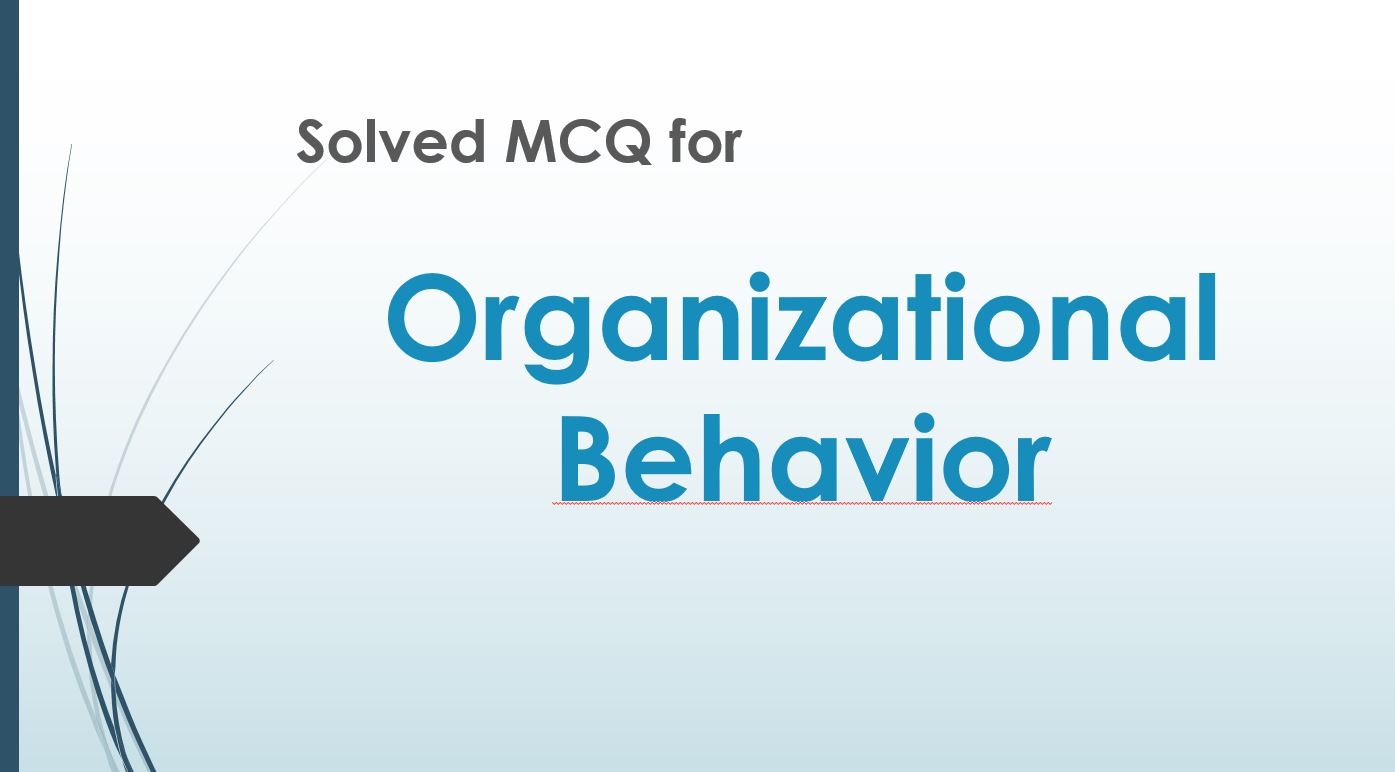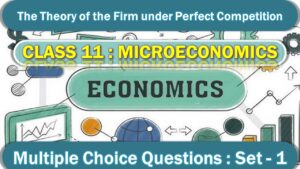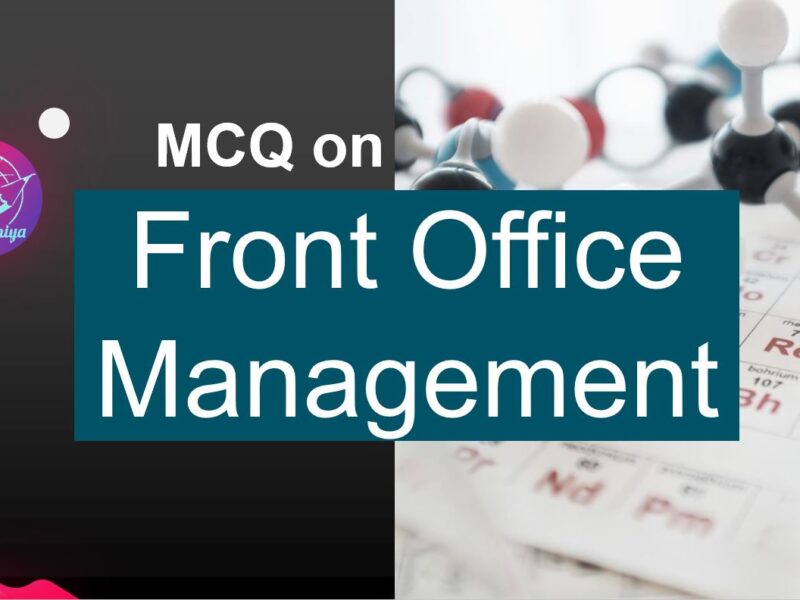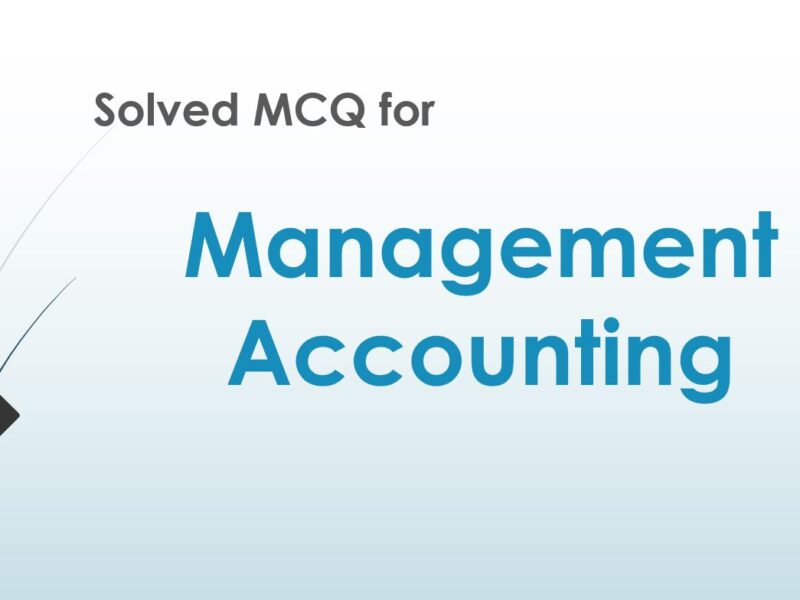MCQ on Organizational Behavior with Answers is Prepared Based on Latest Exam Pattern. Students can solve MCQ on Organizational Behavior with Answers to know their preparation level.
Students who are searching for MCQ on Organizational Behavior with Answers are compiled here to get good practice on all fundamentals. Know your preparation level on MCQ on Organizational Behavior with Answers. You can also verify your answers from the provided MCQ on Organizational Behavior with Answers. So, ace up your preparation with MCQ on Organizational Behavior
MCQ on Organizational Behavior with Answers
Question :1. Individual who achieve the goal through other people is/are
(a) Individual
(b) Group
(c) Manager
(d) All of these
Show Answer :
Answer : (C)
Question :2. Which one gave management skill?
(a) Robert Katz
(b) Joe Gracie
(c) Berne
(d) All of these
Show Answer :
Answer : (A)
Question :33. Management skill is associated with
(a) Technical Skill
(b) Human Skill
(c) Conceptual Skill
(d) All of these
Show Answer :
Answer : (D)
Question :4. A field of study investigates the impact that individual, group and structure have on behavior within organizations is known as
(a) Organization Change
(b) Organization behavior
(c) Organization Stress
(d) All of these
Show Answer :
Answer : (B)
Question :5. This model focuses better employee satisfaction and security. Under this model Organizations satisfy the security and welfare needs of employee
(a) Custodial Model
(b) Social Psychology
(c) Anthropology
(d) All of these
Show Answer :
Answer : (A)
Question :6. The theory of classical conditioning was given by
(a) Ivan Pavlov
(b) Ellon Mayo
(c) R. P Quion
(d) None of these
Show Answer :
Answer : (A)
Question :7. The theory of classical conditioning grow out of experiment conducted by
(a) Cats
(b) Dogs
(c) Rats
(d) None of these
Show Answer :
Answer : (B)
Question :8. A type of conditioning in which an individual response to some stimulus that would not ordinarily produce such a response is known as
(a) Operand Conditioning
(b) Classical Conditioning
(c) Both a and b
(d) None of these
Show Answer :
Answer : (A)
Question :9. A type of conditioning in which desired voluntary behavior leads to a rewards or prevents punishment.
(a) Operand Conditioning
(b) Classical Conditioning
(c) Both a and b
(d) None of these
Show Answer :
Answer : (A)
Question :10. Managerial grid was given by
(a) Reusis Likert
(b) Blake and Mouton
(c) Curt Lewin
(d) All of these
Show Answer :
Answer : (B)
Question :11. Summation of the attitude of employees is called
(a) Motivation
(b) Morale
(c) Both a and b
(d) None of these
Show Answer :
Answer : (A)
Question :12. OB focuses mainly on how to?
(a) Improve productivity
(b) Reduced turn over
(c) Both a and b
(d) None of these
Show Answer :
Answer : (C)
Question :13. Operand conditioning is given by
(a) B.F Skinner
(b) Elton Mayo
(c) R.P Quion
(d) None of these
Show Answer :
Answer : (A)
Question :14. “People can learn through observation direct experience” it comes under
(a) Operand Conditioning
(b) Classical Conditioning
(c) Social learning
(d) None of these
Show Answer :
Answer : (C)
Question :15. Evaluate statements concerning objects people or events
(a) Attitude
(b) Moral
(c) Both a and b
(d) None of these
Show Answer :
Answer : (A)
Question :16. Who proposed the theory of Cognitive dissonance?
(a) Leon Festinger
(b) Edwin Lake
(c) Taylor
(d) None of these
Show Answer :
Answer : (A)
Question :17. Need hierarchy theory was given by
(a) William Ouchy
(b) Abraham Maslow
(c) Herbert Simon
(d) Elton Mayo
Show Answer :
Answer : (B)
MCQ on Organizational Behavior
with Answers
Question :18. Abraham Maslow lower need include
(a) Physiological & safety
(b) Security
(c) social and need
(d) Ego need
Show Answer :
Answer : (A)
Question :19. Which is/ are the highest need of the Maslow hierarchy
(a) Physiological
(b) Social
(c) Ego need
(d) Self actualization need
Show Answer :
Answer : (D)
Question :20. Douglar Mc Gregor propounded the
(a) Theories X and Y
(b) Theory Z
(c) E R G Theory
(d) None of these
Show Answer :
Answer : (A)
Question :21. Need that are satisfied externally, physiological and safety needs is
(a) Lower level need
(b) Higher order need
(c) Both a and b
(d) None of these
Show Answer :
Answer : (A)
Question :22. Two factor theory was given by
(a) Abraham Maslow
(b) Fredrick Herzberg
(c) Chester Bernard
(d) All of these
Show Answer :
Answer : (B)
Question :23. Working conditions, status and salary are
(a) Maintenance
(b) Hygiene factors
(c) Job Context
(d) All of these
Show Answer :
Answer : (B)
Question :24. Theory Z is related to
(a) India
(b) America
(c) Japanese
(d) None of these
Show Answer :
Answer : (C)
Question :25. Theory Z was developed by
(a) William Ouchy
(b) Herbert Simon
(c) Chester Bernard
(d) All of these
Show Answer :
Answer : (A)
Question :26. Who gave Expectancy theory of motivation
(a) Victor H Vrooh
(b) Herbert Simon
(c) Chester Bernard
(d) All of these
Show Answer :
Answer : (A)
Question :27. There are three groups of cone needs: existence, relatedness and growth. These are in
(a) Theories X and Y
(b) Theory Z
(c) E R G
(d) None of these
Show Answer :
Answer : (C)
Question :28. Achievement, power affiliation is three important needs that explain motivation is given by:
(a) Mc Celland’s
(b) Herbert Simon
(c) Chester Bernard
(d) All of these
Show Answer :
Answer : (A)
Question :29. Transaction analysis is given by
(a) Eric Berne
(b) Herbert Simon
(c) Chester Bernard
(d) All of these
Show Answer :
Answer : (A)
Question :30. Which ego state is “Taught ego” state?
(a) Parent ego
(b) Adult
(c) Child
(d) All of these
Show Answer :
Answer : (B)
Question :31. Which state is “Thinking ego” state?
(a) Parents
(b) Adults
(c) Child
(d) All of these
Show Answer :
Answer : (A)
Question :32. Which state is “Felt ego” state?
(a) Parents
(b) Adults
(c) Child
(d) All of these
Show Answer :
Answer : (C)
Question :33. Johari Window is given by
(a) Joseph Luft & Harry Inghram
(b) Herbert Simon
(c) Chester Bernard
(d) All of these
Show Answer :
Answer : (A)
Question :34. Context Theories of motivation are
(a) Theory X and Y
(b) Two factor theory
(c) E R G & need hierarchy theory
(d) All of these
Show Answer :
Answer : (D)
MCQ on Organizational Behavior
with Answers
Question :35. Which is the function of super ego?
(a) The formulation of rules
(b) The choice of values
(c) The evolution of self concept
(d) The process of self judgment
Show Answer :
Answer : (D)
Question :36. Who is the developed of “Two Factors Theory” of motivation?
(a) Heszberg
(b) M C Gregor
(c) Taylor
(d) Fayol and V.Gerald
Show Answer :
Answer : (A)
Question :37. Human motives are developed by
(a) A.H Maslow
(b) M C Gregor
(c) Taylor
(d) Fayol and V.Gerald
Show Answer :
Answer : (A)
Question :38. Which is hygiene factor of Herzberg Two Factor Theory
(a) Salary
(b) Company Policy and administration
(c) Supervision
(d) Working Condition
Show Answer :
Answer : (D)
Question :39. In Vrooms expectancy theory, expectancy indicates
(a) Probability of achieving that outcome
(b) Accounting
(c) Award
(d) Advancement
Show Answer :
Answer : (A)
Question :40. Theory X is a Theory of?
(a) Planning
(b) Financial Planning
(c) Motivation
(d) Controlling
Show Answer :
Answer : (C)
Question :41. Expectancy theory developed by:
(a) Maslow
(b) Vroom Victor
(c) Robinson
(d) Alfred
Show Answer :
Answer : (B)
Question :42. Theory Z was developed by:
(a) Mc Gregor
(b) William Ouchy
(c) Vroom Victor
(d) Maslow
Show Answer :
Answer : (B)
Question :43. Johari Window was propounded by:
(a) Joe Luft and Harry Ingham
(b) Sgmond Froud
(c) Abraham Maslow
(d) Henry Fayol
Show Answer :
Answer : (A)
Question :44. Grid organization development developed by
(a) Maslow
(b) Vroom
(c) Adams
(d) Blake and Mounton
Show Answer :
Answer : (D)
Question :45. Who developed a three stage model of Planned change
(a) Kust Lewin
(b) Vicor Vroom
(c) Alfred Marshal
(d) Henry Herzberg
Show Answer :
Answer : (A)
Question :46. Which is the first stage of Conflict
(a) Perceived conflict
(b) Latent conflict
(c) Felt conflict
(d) Manifest conflict
Show Answer :
Answer : (A)
Question :47. A situation that causes after the conflict is eliminated
(a) Perceived conflict
(b) Latent conflict
(c) Felt conflict
(d) Manifest conflict
Show Answer :
Answer : (D)
Question :48. The propounder of “Logical Incrementalism” was developed by
(a) Kurt Lewin
(b) Brain Quinn
(c) Alfred Marshall
(d) Doglas Mc Gregor
Show Answer :
Answer : (D)
Question :49. Force field analysis was proposed by:
(a) Brain Quinn
(b) Alfred Marshall
(c) Kurt Lewin
(d) Maslow
Show Answer :
Answer : (C)
Question :50. Human relation theory was developed by
(a) Maslow
(b) Frederic Herzberg
(c) Elton Mayo
(d) Kurt Lewin
Show Answer :
Answer : (C)
Question :51. The Behavioral Science Theory believes in
(a) Intrapersonal relation
(b) Interpersonal relation
(c) None of these
Show Answer :
Answer : (B)
MCQ on Organizational Behavior
with Answers
Question :52. Process management was propounded by
(a) Alfred Marshal
(b) Henry Fayol
(c) Abraham Maslow
(d) Frederic Herzberg
Show Answer :
Answer : (B)
Question :53. “General and Industrial management” the famous work of
(a) Henry Fayol
(b) Elton Mayo
(c) Maslow
(d) Marshal
Show Answer :
Answer : (A)
Question :54. Scientific management theory was propounded by
(a) Maslow
(b) Henry Herzberg
(c) F W Taylor
(d) Fredric Herzberg
Show Answer :
Answer : (C)
Question :55. Bureaucracy was developed by
(a) Henry Fayol
(b) Marx Webber
(c) F.W Taylor
(d) Fedric Herzberg
Show Answer :
Answer : (D)
Question :56. Five forms of organizational structure developed by:
(a) Henry Minzberg
(b) Maslow
(c) Elton Mayo
(d) Fedric Herzberg
Show Answer :
Answer : (A)
Question :57. “In search of excellence” the famous work of
(a) Abraham Maslow
(b) Peters and Waterman
(c) Federic Herzberg
(d) Porter-Lawer
Show Answer :
Answer : (B)
Question :58. The technique of “sociometry” to measure social relationship developed by
(a) Maslow
(b) James Victor
(c) Jacob L Moreno
(d) Feredic Herzberg
Show Answer :
Answer : (B)
Question :59. Life Cycle theory of leadership was developed by
(a) House and Mitchel
(b) Paul Herzby and Kenneth Blenhad
(c) Abraham Maslow
(d) Federic Herzberg
Show Answer :
Answer : (B)
Question :60. The word MBO stands for
(a) Management by Organization
(b) Management by Operation
(c) Management by Objectives
(d) None of these
Show Answer :
Answer : (C)
Question :61. MBO gives emphasis on
(a) Top Management
(b) Middle Management
(c) Objectives
(d) Lower Management
Show Answer :
Answer : (C)
Question :62. Two factor theory is also known as
(a) Theory X and Y
(b) Motivation Hygiene Theory
(c) Achievement Theory
(d) None of these
Show Answer :
Answer : (B)
Question :63. ——————communication is also known as Grape Wine
(a) Formal
(b) Informal
(c) Lateral
(d) None of these
Show Answer :
Answer : (B)
Question :64. ——————vested with negative motivation
(a) Achievement Theory
(b) Theory X
(c) Theory Y
(d) All of these
Show Answer :
Answer : (B)
Question :65. Achievement Theory is concerned with
(a) Affiliation
(b) Power
(c) Achievement
(d) All of these
Show Answer :
Answer : (D)
Question :66. The desire to reach the peak of ones potential is called as:
(a) Self-actualization need
(b) Safety need
(c) Esteem need
(d) Social need
Show Answer :
Answer : (A)
Question :67. ——————–is the need for love and affection
(a) Safety
(b) Esteem
(c) Social
(d) Physiological
Show Answer :
Answer : (C)
Question :68. According to Need Hierarchy Theory, the human needs are:
(a) Limited
(b) Unpredictable
(c) Unlimited
(d) All of these
Show Answer :
Answer : (C)
MCQ on Organizational Behavior
with Answers
Question :69. ————leadership is also referred as fatherly leadership
(a) Automatic
(b) Participative
(c) Free rein
(d) Paternalistic
Show Answer :
Answer : (D)
Question :70. ———————is vested with democratic style of leadership
(a) Negative motivation
(b) Centralization of Authority
(c) Decentralization of Authority
(d) One way Communication
Show Answer :
Answer : (C)
Question :71. Transactional analysis was developed by
(a) Abraham Maslow
(b) Federic Herzberg
(c) Eric Berne
(d) James Oven
Show Answer :
Answer : (C)
Question :72. The sequence o group development is
(a) Forming, Storing, Norming, Performing, Adjourning
(b) Strorming, Norming, Forming, Performing, Adjourning
(c) Norming, Strorming, Forming, performing, Adjourning
(d) Forming, Norming, Storming, Performing, Adjourning
Show Answer :
Answer : (A)
Question :73. Subordinates of moderate maturity who have high willingness but lack of ability
(a) Telling
(b) Selling
(c) Participating
(d) Delegating
Show Answer :
Answer : (B)
Question :74. If the workers have both ability and willingness to work, the suitable leadership style is:
(a) Telling
(b) Selling
(c) Participating
(d) Delegating
Show Answer :
Answer : (C)
Question :75. Path goal model of leadership was developed by:
(a) Henry – Blenchard
(b) Robert House
(c) Maslow
(d) Federic Herzberg
Show Answer :
Answer : (A)
Question :76. The authoritarian leadership style goes with
(a) Theory X
(b) Theory Y
(c) Theory Z
(d) None of these
Show Answer :
Answer : (A)
Question :77. The Democratic leadership style goes with
(a) Theory X
(b) Theory Y
(c) Theory Z
(d) None of these
Show Answer :
Answer : (B)
Question :78. Likert believed the following types of types of leaders to be more effective
(a) Job – Centered
(b) Production – Oriented
(c) Task – oriented
(d) People – Oriented
Show Answer :
Answer : (D)
Question :79. Managerial Grid suggest the following as the best leader – behavior
(a) Low structure and low consideration
(b) High concern both for production and people
(c) Low concern both for production and people
(d) High structure and low consideration
Show Answer :
Answer : (B)
Question :80. Environment is synonymous with
(a) Task
(b) Relations
(c) People
(d) Situational variables
Show Answer :
Answer : (B)
Question :81. The Great man theory of leadership led to the raise of
(a) Behavioral theory of leadership
(b) Trail theory of leadership
(c) Situational theory of leadership
(d) None of these
Show Answer :
Answer : (B)
Question :82. According to Herzberg motivation hygiene theory which one of the following is a motivating factor
(a) Job security
(b) Work itself
(c) company policy
(d) Interpersonal relations characters
Show Answer :
Answer : (D)
Question :83. Which of the following is a characteristics of automatic leader
(a) Strict
(b) Incompetent
(c) Benevolent
(d) Free rein
Show Answer :
Answer : (A)
Question :84. Hot stove rule was developed by:
(a) Herzberg
(b) Maslow
(c) Porter – Lower
(d) Mc Gregor
Show Answer :
Answer : (D)
Question :85. Theory “Y” approximates to
(a) employee orientation
(b) Employment orientation
(c) Production orientation
(d) Input orientation
Show Answer :
Answer : (A)
MCQ on Organizational Behavior
with Answers
Question :86. “It incorporates the relationship between perception, effort, expected reward and satisfaction.” The reference is to the ———————–of motivation.
(a) Porter – Lawer expectancy model
(b) Fielders contingency model
(c) Vrooms contingency model
(d) None of these
Show Answer :
Answer : (A)
Question :87. The managerial function of guiding overseeing and leading people is:
(a) Planning
(b) Motivating
(c) Directing
(d) Coordinating
Show Answer :
Answer : (C)
Question :88. Total quality management is a ————— oriented function
(a) People
(b) Quality
(c) Production
(d) None of these
Show Answer :
Answer : (A)
Question :89. Fiduciaries are also known as:
(a) Pension trustees
(b) Entrepreneurs
(c) Career sponsor
(d) Counselors
Show Answer :
Answer : (A)
Question :90. CIRO approach to training and development stands for
(a) Content, initiative, response, and output
(b) Content, input, response, and operation
(c) Content, input, reliable and output
(d) Content, input, relation and output
Show Answer :
Answer : (D)
Question :91. Which of the following is not a way to calculate wage differentials?
(a) Job evaluation
(b) Recruitment
(c) Employee appraisal
(d) Wage survey
Show Answer :
Answer : (D)
Question :92. Effort reward relationship is considered in
(a) Vrooms theory of motivation
(b) Mc Cellands theory of motivation
(c) Equity theory of motivation
(d) None of these
Show Answer :
Answer : (C)
Question :93. Which of the following is an important dynamic variable?
(a) Superiors style and behavior
(b) Organizational nature
(c) The task structure
(d) Cultural variables
Show Answer :
Answer : (B)
Question :94. Mc Gregor Theory X approximates to:
(a) Employee orientation
(b) Employment orientation
(c) Production orientation
(d) Input orientation
Show Answer :
Answer : (C)
Question :95. In equity theory the employee are not motivated when:
(a) The reward is proportionate to the work
(b) The reward is not proportionate to the work
(c) Reward is more than the exception
(d) Anyone of the above
Show Answer :
Answer : (B)
Question :96. The total number of protected workman to be in an organization is————–
(a) Minimum 10 Maximum 120
(b) Minimum 5 Maximum 100
(c) Minimum 15 Maximum 125
(d) None of the above
Show Answer :
Answer : (B)
Question :97. Theory Y approximates to:
(a) Employee orientation
(b) Employment orientation
(c) Production orientation
(d) Input orientation
Show Answer :
Answer : (A)
Question :98. The “carrot and stick “ theory of motivation is related to
(a) Theory of X
(b) Theory of Y
(c) Maslows Need Hierarch
(d) None of these
Show Answer :
Answer : (A)
Question :99. Michigan Leadership studies are based on the following approach to the study of leadership
(a) Trait Approach
(b) Attitude criterion
(c) Behavior Approach
(d) Situational Approach
Show Answer :
Answer : (D)
Question :100. Who is the father of Quality control circles ?
(a) Lewin
(b) Ishikawa
(c) Udpa
(d) None of these
Show Answer :
Answer : (A)




